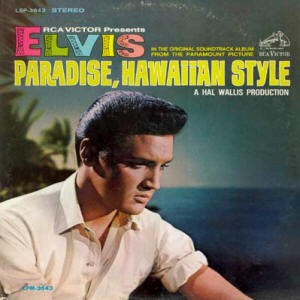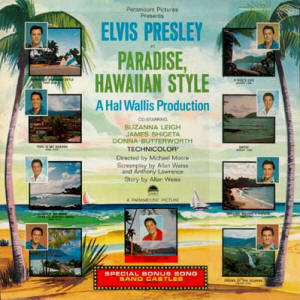Verdict
With the exception of two songs the music is mediocre at best, the audio quality is lousy and over long stretches Elvis sounds downright bored. The highlight of the album is the atmospheric cover.
![]()
(C) RCA Records
The ultimate site about the king of the analogue age


A month before Paramount released "Paradise, Hawaiian Style" RCA Victor shipped the accordant soundtrack album. In its initial sales period the record was retailed 225,000 times. It entered the "Top LPs Chart" on July 16, 1966 and peaked at number 15 during its run of 19 weeks. In Great Britain "Paradise, Hawaiian Style" was very popular and reached number 7. When it was re-released in 1980 it peaked at number 53. Worldwide the album sold 2.5 million copies, which translates to 375 million paid streams of the complete album or 3.75 billion streams of individual songs. Commercially "Paradise, Hawaiian Style" did better than the previously released "Frankie And Johnny", but it never rose above the level of "Girl Happy" and "Harum Scarum".
In 2016 the complete Presley catalogue was restored and remastered by Vic Anesini for a boxed set of 60 compact discs called "The Album Collection". Sony Music Entertainment provides the streaming platforms with the same versions of the individual albums (some of them offering bonus tracks), albeit in 24 bit/90 khz flac. That means, if the platform of your choice supports high resolution audio, you can enjoy the tracks in the same quality Sony used to scan and master them. On Spotify, which has a market share of approximately 30% and is the only platform that publishes streaming figures, "Paradise, Hawaiian Style" accumulates 3 million streams and is requested 1.2 thousand times per day. Therefore the album is another example of movie muzak, that doesn't attract anyone without the cross-promotion effect of the accordant film.
For the album sleeve RCA Victor used a photo made on the set of "Fun In Acapulco" in 1963. The smaller pictures on the backside were made in connection with "Paradise, Hawaiian Style". The reason to use an old photo on the front cover was Elvis' weight. In 1965 he had gained a few pounds and even though he was far from being fat his manager regarded him a tad too chubby to be sold as the ultimate ladies' man.
The recording sessions were scheduled on July 26th and 27th, 1965 at Radio Recorders in Hollywood/California. Because Elvis failed to show up because of an illness, just the music tracks were produced. The band consisted of Scotty Moore (guitar), D.J. Fontana (drums), Barney Kessel (guitar), Charlie McCoy (guitar), Ray Siegel (bass), Hal Blaine (drums), Milton Holland (drums), Larry Muhoberac (piano) and Bernie Lewis (steel guitar). The harmony vocals were provided by The Jordanaires (Gordon Stoker, Hoyt Hawkins, Neal Matthews and Ray Walker). Between August 2nd and 4th Elvis added his voice. On August 3rd he also recorded "Sand Castles" and was accompanied by Howard Roberts (guitar), Alton Hendrickson (guitar), Keith Mitchell (bass) and Victor Feldmann (drums). Both sessions were produced by Joseph Lilley and engineered by Dave Weichman. Until now the soundtracks of the Paramound movies had offered a better audio quality than the ones of the MGM productions. That changed with "Paradise, Hawaiian Style". Suddenly the king's voice was also brought to the fore a little too much and everything sounded muffled and dull. In total the album has a running time of 22:20 minutes.
In 2004 Follow That Dream Records released a special editon, which also included outtakes. For a review tap HERE.
Paradise, Hawaiian Style
Because the movie was to be named "Hawaii USA" Bill Giant, Bernie Baum and Florence Kaye wrote a song of that title. When Paramount changed the name to "Paradise, Hawaiian Style" the trio Giant/Baum/Kaye also changed the name of their song, but left everything else as it was. And so the name doesn't appear anywhere in the song. The lyrics describe the beauty of the islands, the melody doesn't meet my taste at all. In 1973 NBC used the track in the special "Aloha From Hawaii Via Satellite". The music track was recorded on July 27, 1965, Elvis vocals followed on August 4th. The master is a combination of take 8 (rhythm track) and the takes 3 and 4 (vocal track).
Queenie Wahine's PapayaIn the movie Elvis performs the song with the 9 years old Donna Butterworth, on the album he's singing the song alone. "Queenie Wahine's Papaya" was also written by Bill Giant, Bernie Baum and Florence Kaye and is also a mediocre affair. For the movie scene the song is nice enough, but on an album it sounds just odd. The band needed three takes to get it right, but Elvis had to record six takes and two insert-takes with the beginning of the song. His performance had to be spliced of instert-take 2 and take 6.
Scratch My BackOn the silver screen this one also is presented as a duet, this time with Marianna Hill, who portraits one of the king's many ex-girlfriends. Of course the record version features just Elvis. Once again it's a composition by Bill Giant, Bernie Baum and Florence Kay and once again the song is not really a good one. The master is a combination of the takes 4 (rhythm track, recorded on July 26, 1965) and 2 (vocal track, recorded on August 3, 1965).
Drums Of The IslandTo add some folklore Sid Wayne and Roy C. Bennett turned the traditional "Bula Lai" into "Drums Of The Island". Because the Polynesian Cultural Center held the copyright, it was given writer credits and therefore a third of the royalties. This song is the highlight of the movie, staged in front of a beautiful scenery and with hundreds of extras. The musicians finished "Drums Of The Island" off in two takes, while Elvis had to tape six attempts and three insert-takes with the finale. The vocal track is a splice of take 6 and insert-take 3.
Datin'With this children's song Elvis explains the mating behavior of the adults to Donna Butterworth. On the record the tune is acceptable, at least if one knows that it's a soundtrack and the song is from a movie scene. "Datin'" was written by Fred Wise and Randy Starrr and recorded on July 26th and Augst 1st. The musicians were done after two takes, but Elvis constantly had to laugh and needed 14 attempts to get it right.
A Dog's LifeElvis recorded his part on August 1, 1965 within 9 takes, the band had taped the music on July 27th and needed 5 takes. In the movie Rick (Elvis) transports the dogs of a rich lady in his helicopter and thinks about how good a dog's life is. The writers are Sid Wayne and Ben Weisman, neither the melody, nor the lyrics of "A Dog's Life" are all that sophisticated.
A House Of SandThis one is another mediocre movie tune, once again penned by Giant/Baum/Kaye. It tryes to be modern with a hard played electric guitar, but it has nothing to do with anything the young generation did at the time. The rhythm track was taped on July 27, 1965 within 7 takes, the vocal track was finished off in a single attempt.
Stop Where You AreSurprise, surprise! A song written by Bill Giant, Bernie Baum and Florence Kaye! On the silver screen the action is stopped every time Rick (Elvis) sings the word "stop". This idea is just as crazy and innovative as the song. Elvis' vocal track, recorded on August 3rd, had to be spliced of the takes 3, 6 and 9 to reach a satisfactory result. The music track was recorded within a single take (on July 27th).
This Is My HeavenThe soundtrack ends with another tune penned by...well, you know who it was. The melody of the ballad is dull and Elvis' vocals sound rather bored than romantic. Once again the king didn't manage to deliver a master take, so it had to be spliced of the takes 6 and 8. The musicians needed five attempts do get it right.
Sand Castles (bonus song)
As a bonus we hear "Sand Castles", a ballad
written by Herb Goldberg and David Hess. The
song is simple, yet effective and very well
performed. Elvis recorded "Sand Castles" on
August 2, 1965 live with a band within ten
takes. The harmony vocals were taped separately,
here take 2 was used. Of course the tune was not
recorded as a bonus, but it was simply cut from
the movie. To me this is an absolute mystery,
because next to "Drums Of The Island" this
ballad is the only song on this soundtrack worth
listening to.
With the exception of two songs the music is mediocre at best, the audio quality is lousy and over long stretches Elvis sounds downright bored. The highlight of the album is the atmospheric cover.
![]()
(C) RCA Records